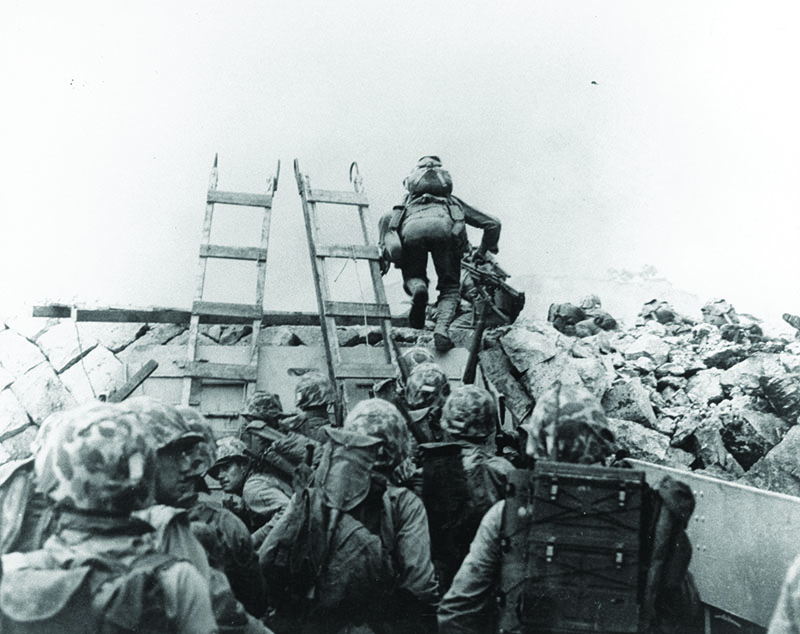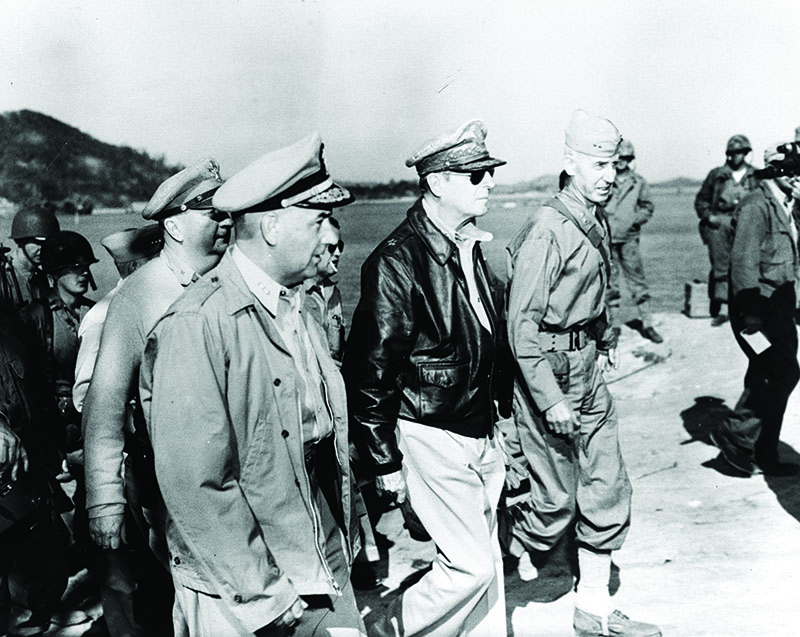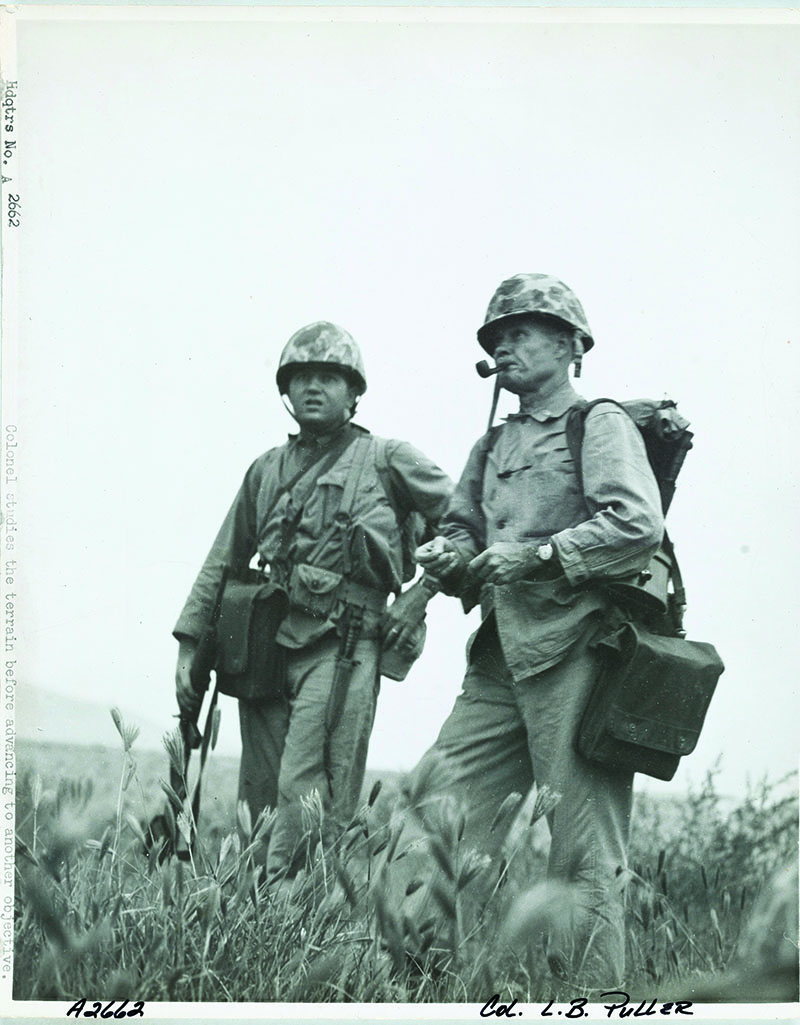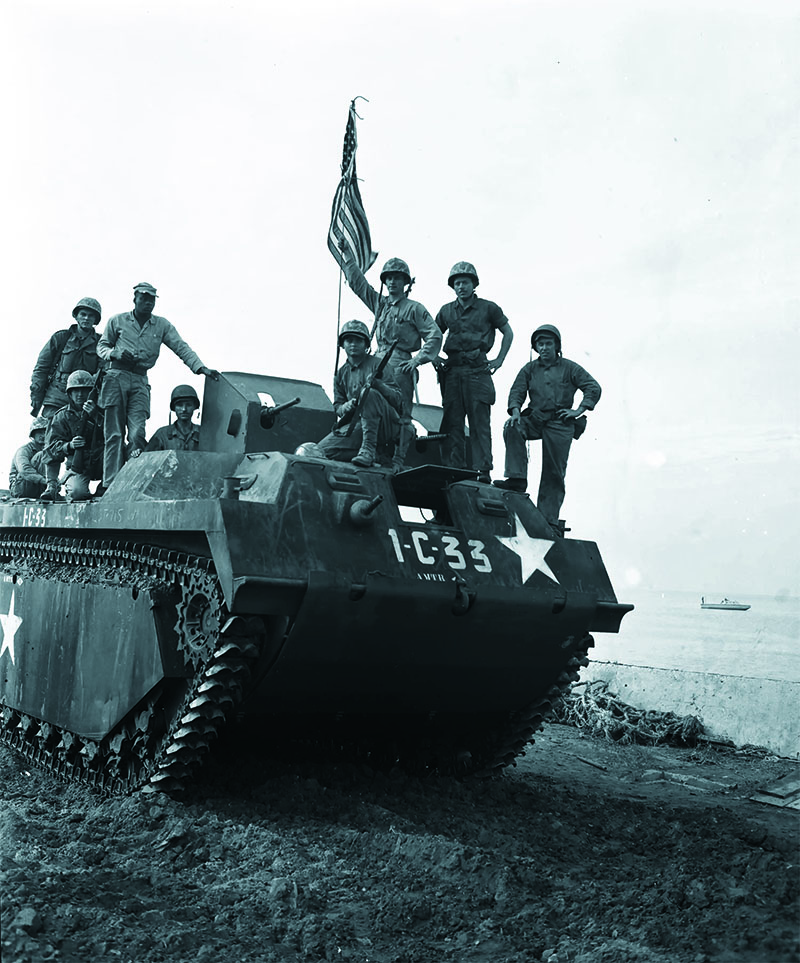
Making the Impossible Look Easy: Operation Chromite
By: Chris KuhnsPosted on June 15, 2025
As Americans read their morning newspapers on Sept. 15, 1950, headlines such as “Seoul Port Isle Falls to Marines in Brief Battle” in Washington D.C.’s The Evening Star caught them by surprise. Across the country, this is the way almost every citizen learned of Inchon, which had been seized by the 1st Marine Division. The articles featured on the front page of that day’s Evening Star described the amphibious assault, including naval bombardment, napalm strikes and Marine landings.
Reading the column, one might assume the operation was easy for the Navy and Marine Corps. However, the articles failed to convey the truly Herculean task involved in executing the landings at Inchon, called Operation Chromite. The Navy and Marine Corps faced an almost impossible challenge: They were expected to call up their reserves, sail across the globe and plan an invasion within three months—a feat that directly contradicted the doctrine developed during the Pacific campaigns of World War II.
Just a few months earlier, on June 25, the North Koreans poured across the 38th Parallel. In just over 30 days of fighting, the North Koreans had the Republic of Korea and U.S. forces with their backs to the wall in the southeast corner of the Korean peninsula, the Pusan Perimeter. The theater commander, General Douglas MacArthur, USA, conceived the idea to relieve the Pusan Perimeter with an amphibious assault during the first week of July. This assault, which would have used the 1st Cavalry Division and an airborne regimental combat team drop, never came to fruition as the 1st Cavalry was needed at Pusan. The idea was then reluctantly agreed to by the Joint Chiefs of Staff, who looked to the Navy and Marine Corps to carry it out.
The Buildup
Due to budgetary restrictions in the massive post-WW II drawdowns, the Marines were just 74,279 active-duty Marines, with only 7,779 Marines in 1stMarDiv. With the agreement of Gen Clifton Cates, the 19th Commandant of the Marine Corps, the Joint Chiefs of Staff had slated 1stMarDiv and the 1st Marine Air Wing (MAW) to conduct MacArthur’s amphibious operation. First, the division had to reach war-time strength, and it was woefully short. Second Marine Division and the security forces were cannibalized, with thousands of Marines sent from Marine Corps Base Camp Lejeune to Camp Pendleton by August 1950.

To achieve a full-strength division, the Marine Corps turned to the Reserve force created after WW II. Many combat veterans from the Pacific campaigns had gone to the reserve, but a portion of the force still consisted of Marines who had never seen active duty or even boot camp. The call went out for thousands of these reservists to report to 1st and 2nd MarDivs for active service. These reservists made the bulk of the manpower behind 1stMarDiv and 1st MAW, preparing to meet the North Korean enemy.
Logistically, the buildup of the Marine forces for Korea was a near impossible feat on its own. Thousands of Marines needed to be equipped and trained for war with mere weeks left before shipping out. Seventh Marines Commander Colonel Lewis B. “Chesty” Puller remembered ordering company commanders to pull mothballed gear and cosmoline-caked weapons from WW II to be issued to arriving Marines. After being equipped, the Marines received rudimentary instruction on weapons, which continued while they sailed to Korea in late August 1950. Despite the hardships of forming a division in only two months, 1stMarDiv and 1st MAW were all en route to or in Korea by the end of August, following the timeline to conduct an amphibious operation in September 1950. With the 1st, 5th and 7th Marine Regiments being shipped out at different times, there was no opportunity for the entire division to make preparations or practice assaults prior to the scheduled invasion.
Operation Chromite
The Navy and Marine Corps, drawing on their vast experiences in WW II, began formulating ideas of landing beaches suitable for amphibious operations. It was noted that the east coast beaches presented many more acceptable landing sites than the west coast beaches. GEN MacArthur, Commander of Far East Forces, was presented multiple locations with acceptable conditions for an amphibious assault. However, MacArthur was dead set on a place called Inchon.
Navy and Marine planners noted that the port of Inchon was the worst possible location for an amphibious assault. The approach to the harbor was bottlenecked by two peninsulas, perfect for underwater mines. In the harbor, the tidal range was one of the most volatile in the world, leaving Sept. 15 as the only day with enough water clearance for landing craft. Further, the tides restricted landing to just two windows: a few hours in the morning and late afternoon. If that wasn’t enough, offshore islands dominated the approaches to the landing beaches. Once on the beaches, Marines would have to contend with a concrete seawall or a mud flat, leaving virtually no beach exit for vehicles.
Defending Inchon was the 226th Independent Marine Regiment of the North Korean People’s Army’s (NKPA), supported by the 918th Artillery Regiment. Nearby in Seoul was the 18th Infantry Division and the 42nd Mechanized Regiment, equipped with Soviet T-34s. The only redeeming factor for the selection of Inchon was that it was the closest harbor to Seoul. MacArthur’s entire strategy revolved around capturing Seoul by an arbitrarily picked date at the end of September. Despite almost unanimous objections to Inchon, MacArthur pressed his decision, again receiving a begrudging approval from the Joint Chiefs of Staff.

Joint Task Force 7, comprised of 1stMarDiv under Major General O.P. Smith; 7th Infantry Regiment, 1st MAW; and a multinational array of naval vessels, approached Inchon on Sept. 10. Navy and Marine planners continued meeting day in and day out to finalize the plans for the Inchon invasion, even while sailing toward their ultimate objective.
Opening the invasion were Marine F4U-4B Corsairs from Marine Fighter Squadrons 214 and 323, which began softening up the landing area with bombs and napalm. Looking toward shore, observers saw the gull-winged fighters delivering their deadly payloads. Moving cautiously into the harbor, the Navy detected multiple mines guarding the narrow approach. For the next few days, minesweepers, covered by destroyers, made the harbor safe for the landing craft to proceed. This task was made increasingly difficult as shore batteries opened on the ships. The ships responded in turn, leveling the positions. With the mines and approaches clear, the way was paved for the Marines to go ashore. The final day loomed before them—Sept. 15, 1950, was their day to pull off the impossible.
Green Beach
Before the Marines could proceed to Inchon, they first had to take Wolmi-do, the offshore island. On the morning of the 15th, the calm darkness was shattered by the whine of Corsairs and the pounding of their bombs. Around 6:30 a.m., the racket suddenly ceased, replaced by the humming of landing craft. The Marines of 3rd Battalion, 5th Marines, stormed ashore and swarmed the island.
They encountered little resistance, finding only small pockets of North Koreans holed up in caves. When hand grenades proved ineffective, enterprising Marines flagged down an M26 Pershing tank rumbling off a landing craft. The tank, specially equipped with a bulldozer blade, approached a cave. Withstanding a flurry of last-ditch resistance, the tank lowered its blade and shoved a wall of debris into the cave mouth, sealing the defenders’ fate.
The Marines continued their advance, crushing what little resistance they encountered. At 8 a.m., Colonel Robert Taplett, commander of 3/5, reported Wolmi-do secure with only 17 casualties. Soon, the tide receded, leaving only sticky muck in the harbor. Across the island, Marines settled into defensive positions to wait out the next few hours until the rest of the division arrived. Only an hour and a half of daylight was expected after the afternoon landings took place; if anything went wrong, 3/5 would be isolated on Wolmi-do.

Blue Beach
The naval bombardment picked up again at 2:30 p.m., softening up the remaining beaches. At 5:30, the Marines started for shore. Chesty Puller’s 1st Marines piled out of their landing craft onto Blue Beach, which was inundated with smoke and fog. Once again, the Marines encountered little resistance. What held them up was the deep quagmire that made up most of Blue Beach. The landing craft got stuck across the beach, forcing Marines to trudge ashore through the mud. Compounding the problems, some follow-on troops landed in the wrong location and had to march across the peninsula to rejoin the rest of the regiment.
Despite the mud and confusion, Marines streamed ashore and swiftly overwhelmed any resistance they encountered. Most of the enemy consisted of isolated bunkers, like on Wolmi-do, which were reduced with tanks, flamethrowers, grenades and tenacity. By nightfall, the 1st Marines paused their advance on the hills overlooking the beach. Despite the setbacks of the confused landing, the 1st Marines were ready to push on through Inchon the following day. Across the peninsula, Marines in the 5th Marine Regiment were facing a much different landing.
Red Beach
On Red Beach, Lieutenant Colonel Raymond Murray’s 5th Marines broke through the smoke in landing craft, revealing the looming concrete seawall. The deceptively named Red Beach had no beach at all. The water lapped directly against the wall, which in some places towered 4 feet above the landing craft. Simple ingenuity got the Marines ashore: Navy coxswains maneuvered their craft against the seawall, gunning the engines to keep the ramps pressed tight against the concrete. Marines hurled grenades over the top before bracing wooden ladders up the ramp and wall. One by one, they clambered up and over, enemy bullets snapping overhead.
Once ashore, the Marines faced the fiercest resistance yet. Bunkers and fighting positions dotted the landscape. Unlike previous amphibious assaults, Inchon’s buildings and warehouses extended right to the water’s edge. Marines fought through streets and warehouses, battling to clear out defenders and achieve their objectives.
The fighting on Red Beach resembled the brutal, close-quarters combat of the Central Pacific, nearly a decade earlier. The Marines systematically neutralized NKPA positions, one by one, with grenades and flamethrowers. Close air support, honed to a fine edge by the Navy and Marine Corps, roared in low over the beaches, dropping bombs on targets designated by the battalion forward air controller.

The battle for Red Beach culminated on Observation Hill. This commanding height dominated the surrounding terrain but teemed with NKPA defenders. Night had fallen by the time mixed units from 2nd Bn, 5th Marines, were ready to assault the hill. Eerie light emanated from burning buildings, while muzzle flashes punctuated the darkness. Marines charged up the northern and southern slopes, locked in furious grenade battles with the enemy. Despite taking casualties, they seized the hilltop and dug in to repel counterattacks.
As the fighting subsided and the sounds of battle faded, the smoke and fire from naval shells and napalm illuminated the midnight sky. The 1st and 5th Marines consolidated their positions, reorganizing their units after the chaotic landings. Meanwhile, the Marines on Wolmi-do crossed the causeway to Inchon proper, completing the now-continuous defensive line spanning the peninsula.
One Day Down, Many More to Go
The Sailors and Marines at Inchon had achieved the impossible, successfully executing an amphibious assault on one of the most inhospitable landing sites imaginable. Even more impressively, they had planned, organized and executed the entire operation in less than three months, with half of the planning occurring while the division was at sea. Such a feat would have been unthinkable just a few years earlier. But under the expert leadership of seasoned veterans, from Smith down to platoon and squad leaders, the operation unfolded with minimal casualties. Marines, both veteran and recruit, displayed the courage, tenacity and fighting spirit that have defined the Corps since its inception.
As the sun rose above Observation Hill on the morning of Sept. 16, the Marines beheld a smoldering city before them. Beyond Inchon lay the Han River, which they would need to cross, again relying on their beloved amtracs. And beyond the Han River sprawled Seoul, the capital city, full of twisting alleyways and formidable barricades. Though they didn’t know it then, these Marines were bound for the frozen peaks of the Chosin Reservoir and the most desperate fight of their lives. But for now, they focused on the task at hand, for Inchon was theirs.
Author’s bio: Chris Kuhns, a veteran Marine infantryman, separated from the Corps to pursue his passion for military history, specializing in the history of the United States Marine Corps. He serves as the deputy director of the USMC Historical Company, a 501(c) organization, while also working as a historian for the U.S. Air Force. He calls Gettysburg, Pa., home.




